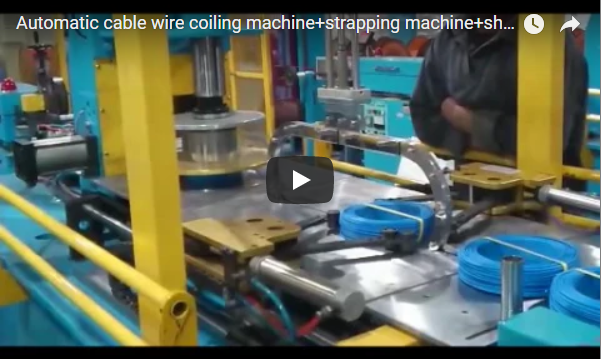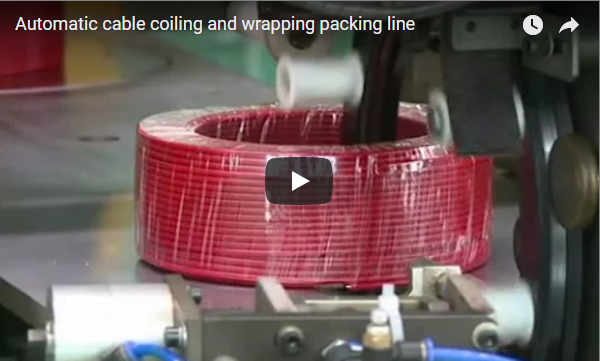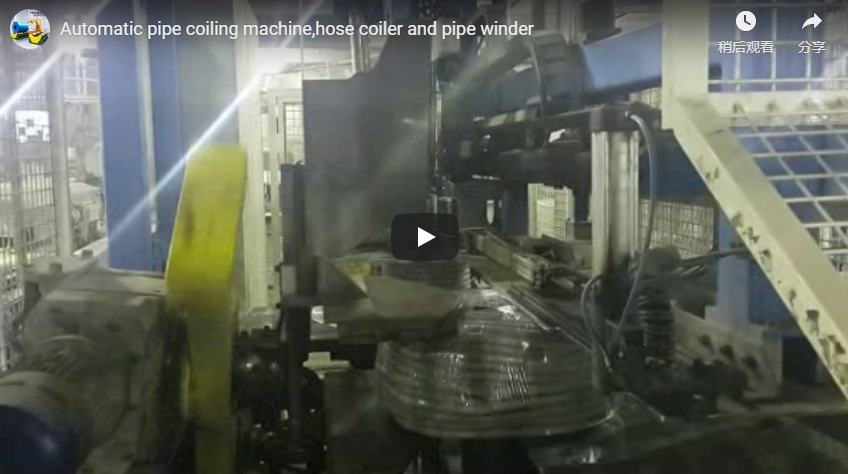Optimizing Production Lines: A Technical Deep Dive into the Online Automatic Cable Winding & Wrapping Machine
Efficient cable management is a critical bottleneck in many manufacturing and extrusion processes. Manual coiling and wrapping are labor-intensive, costly, and prone to inconsistencies in quality and length. The Online Automatic Cable Winding & Wrapping Machine presents a robust, automated solution designed for seamless integration directly into production lines, significantly enhancing throughput and product uniformity. This machine streamlines the process from continuous cable feed to perfectly coiled and wrapped final products.
1. Core Technical Specifications
Understanding the machine's capabilities starts with its technical data. Here’s a breakdown of key parameters:
- Control System: PLC (Programmable Logic Controller) & HMI (Human-Machine Interface)
- Operational Mode: Fully Automatic, Online Integration
- Cable Diameter Range: 2 mm – 12 mm (suitable for a wide variety of electrical wires and cables)
- Coil Inner Diameter (ID): Selectable options, commonly 120 mm or 150 mm (others may be available upon request)
- Coil Outer Diameter (OD): Adjustable based on cable length and ID (typically up to 300-400 mm range)
- Coil Width: Adjustable, synchronized with cable diameter and coiling parameters
- Cable Length Calculation: Automatic via encoder or line speed synchronization
- Cutting Mechanism: Automated pneumatic or servo-driven cutter for precise length termination
- Wrapping Material: PVC stretch film (standard), other film types potentially adaptable
- Wrapping Method: Orbital stretch wrapping for secure and protective packaging
- Coiling Speed: Variable, synchronizable with upstream extrusion or processing line speeds (e.g., up to 100-150 m/min, application dependent)
- Power Requirements: Typically 380V/50Hz/3Phase (configurable)
- Compressed Air: Required for pneumatic components (e.g., 6-8 bar)
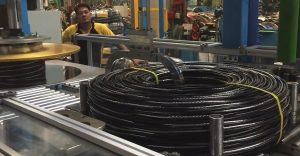
2. Robust Design and Key Components
The machine's reliability and performance are rooted in its design and construction:
- Frame Structure: Heavy-duty steel frame ensures stability and vibration damping during high-speed operation.
- Cable Inlet & Guiding: Precision rollers and guides ensure smooth cable feeding without damage to insulation.
- Coiling Head: Dynamically balanced, servo-driven (often) coiling head for precise winding patterns and tension control. Quick changeover features for different coil IDs are crucial for flexibility.
- Traversing Unit: Synchronized mechanism that guides the cable accurately across the coil width, ensuring level winding.
- Cutting Unit: Hardened steel blades provide clean, square cuts. Integrated with the length measurement system for high accuracy.
- Wrapping Station: Features a film carriage with adjustable stretch tension and overlap control, ensuring a tight, protective wrap.
- Ejection System: Automated mechanism (e.g., pusher or tilting unloader) to transfer the finished coil to a downstream conveyor or collection bin.
- Safety Features: Interlocked guarding, emergency stops, and sensors compliant with relevant safety standards (e.g., CE).
![Illustration of an automatic cable coiling and wrapping machine layout Alt Text: Schematic showing the flow of cable through the guiding system, coiling head, cutting station, wrapping unit, and ejection point of an online automatic cable winder.]
3. Automated Operational Workflow
The "Online" capability means the machine operates continuously as part of a larger production process:
- Cable Feed: The cable enters the machine directly from an extruder, capstan, or other upstream equipment.
- Length Measurement: An integrated encoder wheel or synchronization with the line's master speed reference precisely measures the cable length.
- Coiling: Once the preset length is reached, the coiling head winds the cable into a neat coil of the specified ID and OD. The traversing unit ensures even layering.
- Cutting: The system signals the cutting unit to sever the cable precisely at the measured length.
- Coil Transfer (if applicable): The coiling head may retract or reposition to hand off the coil to the wrapping station.
- Wrapping: The wrapping unit applies the PVC film around the coil's circumference, securing the cable ends and protecting the coil.
- Ejection: The finished, wrapped coil is automatically ejected from the machine.
- Cycle Restart: The machine immediately begins coiling the next length of incoming cable without interruption to the production line.
4. Highlighted Features and Production Benefits
Investing in this automated solution yields significant advantages:
- Increased Throughput: Continuous, high-speed operation dramatically outpaces manual methods.
- Labor Reduction: Frees up personnel from repetitive, manual coiling and wrapping tasks.
- Consistent Quality: Ensures uniform coil dimensions, winding tension, and wrapping integrity for every product.
- Accurate Length Control: Minimizes material waste and ensures compliance with customer specifications.
- Improved Safety: Reduces manual handling risks associated with moving cables and operating wrapping tools.
- Seamless Integration: Designed to communicate and synchronize with upstream and downstream equipment for fully automated lines.
- Data Logging: PLC/HMI systems often allow for production data tracking (coils produced, lengths, fault logging).
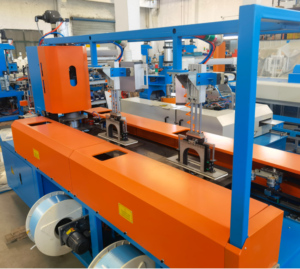
automatic cable coiling2 5. Advanced Control System: PLC & HMI Integration
The brain of the machine offers sophisticated control and user interaction:
- PLC Reliability: Industrial PLCs (e.g., Siemens, Allen-Bradley, Mitsubishi) provide robust, real-time control over all machine functions (motors, sensors, pneumatics).
- Intuitive HMI: Touchscreen interface allows operators to easily:
- Set parameters (cable length, coil ID/OD targets, wrapping settings, speed).
- Monitor machine status and production progress in real-time.
- Access diagnostics and troubleshooting guides.
- Manage recipes for different cable products.
- View alarms and operational history.
- Programmability: Allows for customization of coiling patterns, wrapping cycles, and integration logic.
6. Seamless Production Line Integration
Being an "Online" machine implies specific integration capabilities:
- Synchronization: Can receive start/stop signals and speed reference signals (e.g., 0-10V analog or via industrial network) from the main production line to match its speed precisely.
- Communication: Potential for Ethernet/IP, Profinet, or other industrial communication protocols for data exchange with SCADA or MES systems.
- Buffering (Optional): May incorporate a small accumulator or dancer arm system to manage minor speed fluctuations between the line and the coiler without stopping production.
7. Practical Insights: User Experience and Maintenance
From a user perspective, well-designed machines offer:
- Ease of Setup: Quick recipe loading and straightforward mechanical adjustments (e.g., changing coil ID formers) minimize downtime during product changeovers.
- Reliability: Robust components and sensors reduce unexpected stoppages. Look for designs that protect sensitive parts from dust and debris common in cable production environments.
- Accessibility for Maintenance: Thoughtful design allows access to key components like cutters, rollers, and wrapping film rolls for routine inspection, cleaning, and replacement.
- Common Maintenance Points: Regularly inspect and replace cutting blades, check pneumatic system filters and lubrication, monitor drive belts/chains, and keep sensors clean. Ensure film roll changes are quick and simple.
8. Target Applications and Industries
This type of automated machinery is indispensable in various sectors:
- Wire and Cable Manufacturing: Primary application for packaging finished products after extrusion and cooling.
- Automotive: Coiling wire harnesses or specific cable lengths for automotive assembly.
- Electronics: Preparing cables for consumer electronics or industrial control panels.
- Telecommunications: Coiling fiber optic or coaxial cables.
- Appliance Manufacturing: Handling internal wiring components.
- Construction: Packaging building wire and flexible conduits.
Conclusion: Enhancing Cable Packaging Efficiency
The Online Automatic Cable Winding & Wrapping Machine is a critical asset for modernizing cable production and handling operations. By automating the labor-intensive tasks of coiling, cutting, and wrapping directly within the production flow, it delivers substantial improvements in speed, consistency, cost-effectiveness, and safety. Its integration capabilities, coupled with advanced PLC/HMI control, make it a smart investment for manufacturers seeking to optimize their end-of-line packaging processes and maintain a competitive edge.
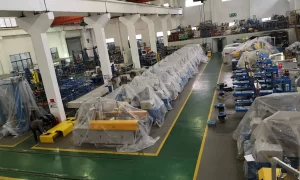
Further Information
For detailed specifications, customization options, or a quotation based on your specific application requirements, please contact the manufacturer:
Website: www.fhopepack.com
Email: coiler@fhopepack.com


